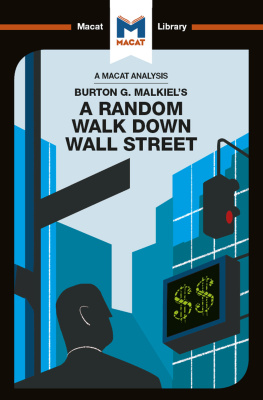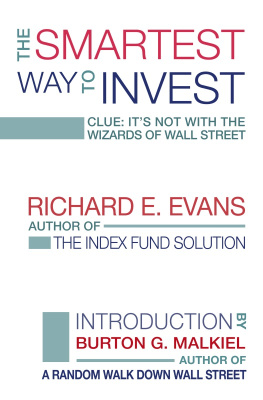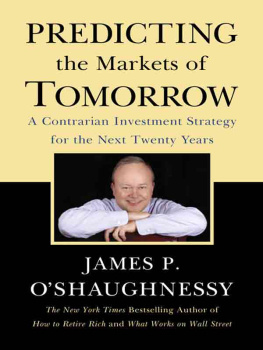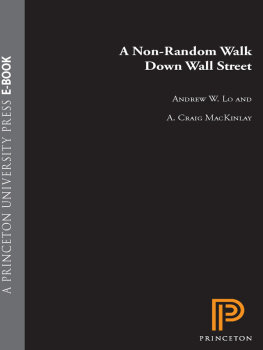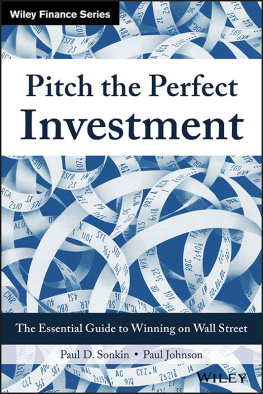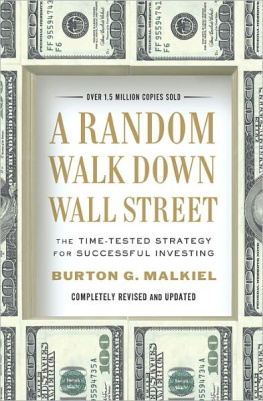Contents
Page List


An Analysis of
Burton G. Malkiels
A Random Walk Down Wall Street
Nick Burton

Published by Macat International Ltd
24:13 Coda Centre, 189 Munster Road, London SW6 6AW.
Distributed exclusively by Routledge
2 Park Square, Milton Park, Abingdon, Oxon OX14 4RN
711 Third Avenue, New York, NY 10017, USA
Routledge is an imprint of the Taylor & Francis Group, an informa business
Copyright 2017 by Macat International Ltd
Macat International has asserted its right under the Copyright, Designs and Patents Act 1988 to be identified as the copyright holder of this work.
The print publication is protected by copyright. Prior to any prohibited reproduction, storage in a retrieval system, distribution or transmission in any form or by any means, electronic, mechanical, recording or otherwise, permission should be obtained from the publisher or where applicable a license permitting restricted copying in the United Kingdom should be obtained from the Copyright Licensing Agency Ltd, Barnards Inn, 86 Fetter Lane, London EC4A 1EN, UK.
The ePublication is protected by copyright and must not be copied, reproduced, transferred, distributed, leased, licensed or publicly performed or used in any way except as specifically permitted in writing by the publishers, as allowed under the terms and conditions under which it was purchased, or as strictly permitted by applicable copyright law. Any unauthorised distribution or use of this text may be a direct infringement of the authors and the publishers rights and those responsible may be liable in law accordingly.
www.macat.com
Cataloguing in Publication Data
A catalogue record for this book is available from the British Library.
Library of Congress Cataloguing-in-Publication Data is available upon request.
Cover illustration: A. Richard Allen
ISBN 978-1-912302-28-4 (hardback)
ISBN 978-1-912128-82-2 (paperback)
ISBN 978-1-912281-16-9 (e-book)
Notice
The information in this book is designed to orientate readers of the work under analysis, to elucidate and contextualise its key ideas and themes, and to aid in the development of critical thinking skills. It is not meant to be used, nor should it be used, as a substitute for original thinking or in place of original writing or research. References and notes are provided for informational purposes and their presence does not constitute endorsement of the information or opinions therein. This book is presented solely for educational purposes. It is sold on the understanding that the publisher is not engaged to provide any scholarly advice. The publisher has made every effort to ensure that this book is accurate and up-to-date, but makes no warranties or representations with regard to the completeness or reliability of the information it contains. The information and the opinions provided herein are not guaranteed or warranted to produce particular results and may not be suitable for students of every ability. The publisher shall not be liable for any loss, damage or disruption arising from any errors or omissions, or from the use of this book, including, but not limited to, special, incidental, consequential or other damages caused, or alleged to have been caused, directly or indirectly, by the information contained within.
CONTENTS
THE MACAT LIBRARY
The Macat Library is a series of unique academic explorations of seminal works in the humanities and social sciences books and papers that have had a significant and widely recognised impact on their disciplines. It has been created to serve as much more than just a summary of what lies between the covers of a great book. It illuminates and explores the influences on, ideas of, and impact of that book. Our goal is to offer a learning resource that encourages critical thinking and fosters a better, deeper understanding of important ideas.
Each publication is divided into three Sections: Influences, Ideas, and Impact. Each Section has four Modules. These explore every important facet of the work, and the responses to it.
This Section-Module structure makes a Macat Library book easy to use, but it has another important feature. Because each Macat book is written to the same format, it is possible (and encouraged!) to cross-reference multiple Macat books along the same lines of inquiry or research. This allows the reader to open up interesting interdisciplinary pathways.
To further aid your reading, lists of glossary terms and people mentioned are included at the end of this book (these are indicated by an asterisk [*] throughout) as well as a list of works cited.
Macat has worked with the University of Cambridge to identify the elements of critical thinking and understand the ways in which six different skills combine to enable effective thinking. Three allow us to fully understand a problem; three more give us the tools to solve it. Together, these six skills make up the PACIER model of critical thinking. They are:
ANALYSIS understanding how an argument is built
EVALUATION exploring the strengths and weaknesses of an argument
INTERPRETATION understanding issues of meaning
CREATIVE THINKING coming up with new ideas and fresh connections
PROBLEM-SOLVING producing strong solutions
REASONING creating strong arguments
To find out more, visit WWW.MACAT.COM.
CRITICAL THINKING AND A RANDOM WALK DOWN WALL STREET
Primary critical thinking skill: EVALUATION
Secondary critical thinking skill: ANAYLSIS
Burton Malkiels 1973 A Random Walk Down Wall Street was an explosive contribution to debates about how to reap a good return on investing in stocks and shares. Reissued and updated many times since, Malkiels text remains an indispensable contribution to the world of investment strategy one that continues to cause controversy among investment professionals today.
At the books heart lies a simple question of evaluation: just how successful are investment experts? The financial world was, and is, full of people who claim to have the knowledge and expertise to outperform the markets, and produce larger gains for investors as a result of their knowledge. But how successful, Malkiel asked, are they really? Via careful evaluations of performance looking at those who invested via technical analysis and fundamental analysis he was able to challenge the adequacy of many of the claims made for analysts success. Malkiel found the major active investment strategies to be significantly flawed. Where actively managed funds posted big gains one year, they seemingly inevitably posted below average gains in succeeding years. By evaluating the figures over the medium and long term, indeed, Malkiel discovered that actively-managed funds did far worse on average than those that passively followed the general market index.
Though many investment professionals still argue against Malkiels influential findings, his exploration of the strengths and weaknesses of the argument for believing investors claims provides strong evidence that his own passive strategy wins out overall.
ABOUT THE AUTHOR OF THE ORIGINAL WORK
Born in 1932, Burton G. Malkiel is one of the most influential American economists specializing in how the stock markets work. After earning an MBA at Harvard University, Malkiel worked for a Wall Street investment firm for a couple of years before moving to academia and gaining a PhD in economics from Princeton. He quickly became a professor, and after a long career is now retired. Malkiel has also acted as a director of many companies, giving him a perspective on both the academic and business worlds. He has served as a member of the Council of Economic Advisers, advising the US president. Malkiel has published numerous books and articles, but is best known for 1973s

